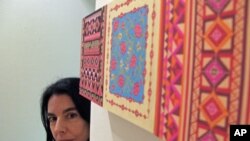The barrier separating Israel from West Bank Palestinian territories is the theme of a Washington exhibit by a dozen U.S. and Canadian-based artists. Each gives a different representation of what the artist views as an obstacle to peace.
The curator at the non-profit and non-partisan Jerusalem Fund Gallery, Dagmar Painter, shows one of the pieces called Twisted Rope, an 18-meter rope made up of men’s headdresses, women’s garments and other fabrics.
“The idea of this piece is that it is a rope long enough for someone to throw over the wall, and then two people could climb one on each side and meet at the top,” said Painter.
Other pieces include pictures of a checkpoint sign made to look like bricks, a tsunami wave breaking down barriers, and a doll inside a sycamore trunk.
The exhibit is called Breaching the Wall.
Israelis commonly refer to the more than 500-kilometer and still gradually lengthening barrier as a separation, security or anti-terrorist fence. Some sections are made up of concrete slabs up to eight meters in height, while other parts of the barrier are barbed wire and electrified fencing.
Lebanese-American artist Helen Zughaib made a piece called Another Wall, which lines up 20 intricately designed miniature panels. Her inspiration was Palestinian embroidery tradition.
“One woman can read another women’s dress and can tell what village she is from by these beautiful intricate motifs that have been carried on from generation to generation,” she said.
Zughaib said she feels the longer the barrier extends, the more these traditions are at risk.
“I think that what a lot of people hear about the wall is that it keeps terrorism out and acts of terror, but in reality it does a lot more than that," she said. "It really does separate people from land, and separate people from their livelihoods, so it affects them so much. I think that part does not necessarily come across. Once you see it you become very aware that the wall does really encroach on people’s lives.”
Several years ago, Zughaib stayed in east Jerusalem, while attending a workshop in the West Bank, and had to cross three of the barrier’s checkpoints in both directions.
Zughaib said art can help eliminate a barrier she views as going against the aim of peaceful coexistence between Israelis and Palestinians.
"I think the more people speak up about it, write about it, take photographs of it, paint it, talk about it, get it out there, to a younger generation, I do think eventually it will come down," she said. "I do no think people are meant to live with walls, so I am optimistic, but I am not sure I will see it in my lifetime, but I hope I do.”
In 2004, the International Court of Justice issued an opinion against the barrier, also calling it a wall, and saying it was contrary to international law. But Israel’s government rejected the ruling and stressed the barrier would continue to be built.










